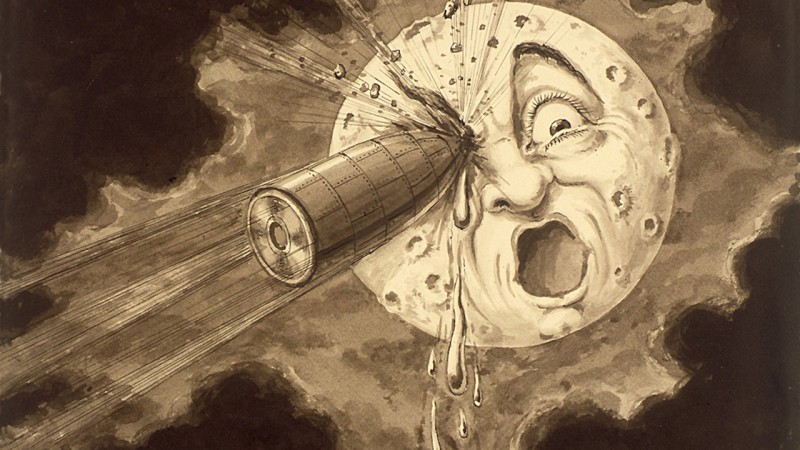First Movies: the adventure begins
Lumiere – Melies
First movies by Lumiere brothers are very simple and show scenes of daily life, even if among these first rudimentary films, we can see some prototypes of grotesque comedy such as in The Sprinkler Sprinkled (l’Arroseur arrosé, 1895). Other important movies are Demolition of a Wall (Démolition d’un mur, 1896), where we can see the first example of a reverse effect and The arrival of a train at La Ciotat (L’Arrivée d’un train en gare de La Ciotat, 1895), nothing but a train arriving to the station, and thanks to the magic of film perspective, as the legend goes, on the first play the audience was so overwhelmed by the moving image that they ran away from the theater.
Subsequently Lumiere brothers devoted themselves especially to documentaries, sending their operators around the world to collect picture of people, cities and characteristic landscapes.
Was the magician Georges Méliès, while playing with a camera built on purpose (the two brothers refused to sell it a camera despite of his incessant demands), due to a machine defect, he discovers something magical: the cut. Thanks to the editing, Melies learns that he cannot only show the world, but also change it at will. The director leaves outside footage to build a magic study where he can shot his fantastic and visionary ideas.
On the same year he had shot Escamotage d'une dame chez Robert-Houdin (1896), giving the illusion of the appearance and disappearance of a woman. Melies used the same technique to realize many other fantasy films, almost always suspended between dream and reality; of these amazing films, virtually everyone know A Trip to the Moon (Le voyage dans la Lune, 1902), first science fiction film ever in the history of film, inspired by Jules Verne’s novel “From the Earth to the Moon“.
Still today, although submerged by a world overflowing with cinematic special effects, watching that movie we can grasp its isochronous magic; and there’s still so much magic to discover.
British Brighton school
The first shot-framing innovations arrived from the “Brighton school” in the south of England, first pioneered by George Albert Smith, who shot The Kiss in the Tunnel (1899), using for the first time the editing to develop a story, splitting the action in three different frames related by the same narrative topic. Smith filmed from a moving train forging a technique called Phantom Ride, that will be reused by many directors in the following decades.
Even James Williamson was an author of early narrative films. Attack on a China Mission (1900) shows a first rudimentary example of alternate editing, and The Big Swallow (1901) presents an example of close-up photography, then formalized using the editing by George Albert Smith in The Sick Kitten (1903), cutting the film and passing cleanly from a mean field to a close-up.
The language was beginning to take shape. We are talking of the first cry of a little baby who tries to say, “I’m here, I’m hungry,” little grumbled shouts, but sweet, sweet like notes played by a young Mozart on his first piano.
When in 1900 in Grandma's Reading Glass, were shown details of objects in a continued action by placing a circular mask on the lens to simulate a magnifying glass, we see the framework of what will be Griffith’s masterpieces and more others. Alfred Hitchcock, for example, will use the exact same technique to realize Rear Window (1954).
Many more years will be necessary to structure the insights of these pioneers, fusing them with a great variety of camera movements, sequence shots and experiments narratively increasingly bold and daring.
Early American cinema
On the other side of the Atlantic, from parts of New York City, Edwin S. Porter, a projectionist assistant of Thomas Edison, began his adventure as director. In 1903, inspired by James Williamson’s Fire! (1901), tried to impart action and pathos to a dramatic movie.
In Fire! there is a rescue of a woman from a burning building. Thanks to editing, were shown different spatial views: from the street and from inside the house. Each cut corresponds to a change of scene and perspective of the viewer, while remaining in a flat linear time, finally freeing cinema from its theatrical origins, introducing the first editing techniques designed for space manipulation.
Life of an American Fireman (1902) introduces these intuitions into the United States, expanding the speech started by Williamson using one of the most used technique today: the opening with a dream of a character (shown in multiple exposure). Using this trick, now consolidated, Porter creates empathy between the audience and the actor, while close-ups and fades make the action fluid and pleasant.
Inspired by Melies attempts to compose a narrative through connected shots (The Dreyfus Affair, 1899), the same year, Porter filmed the first narrative western movie in history, The Great Train Robbery (1903), inspired by a real robbery. The film was a great success and contains many elements that we know very well: criminals, good that wins over evil and a surprise ending: a brilliant scene became famous. At the end of the film in fact, the actor Justus Barnes points the gun at the camera and grinning, shoot into the screen.
Edwin S. Porter filmed some other films that contain brilliant insights, including Capture of the Yegg Bank Burglars (prototype of gangster movie, 1904) and The Kleptomaniac (prototype of social drama, 1905), but then fell into disrepair after the famous crisis of ’29 and decided to devote himself full time to his first passion: photography. Similar unfortunate fate befell George Melies, who ended up on the street and opened a kiosk of candy and toys at Paris-Montparnasse train station, along with his wife and muse, the actress Jeanne d'Alcy as romantically and expertly shown by Martin Scorsese in Hugo (2011).
